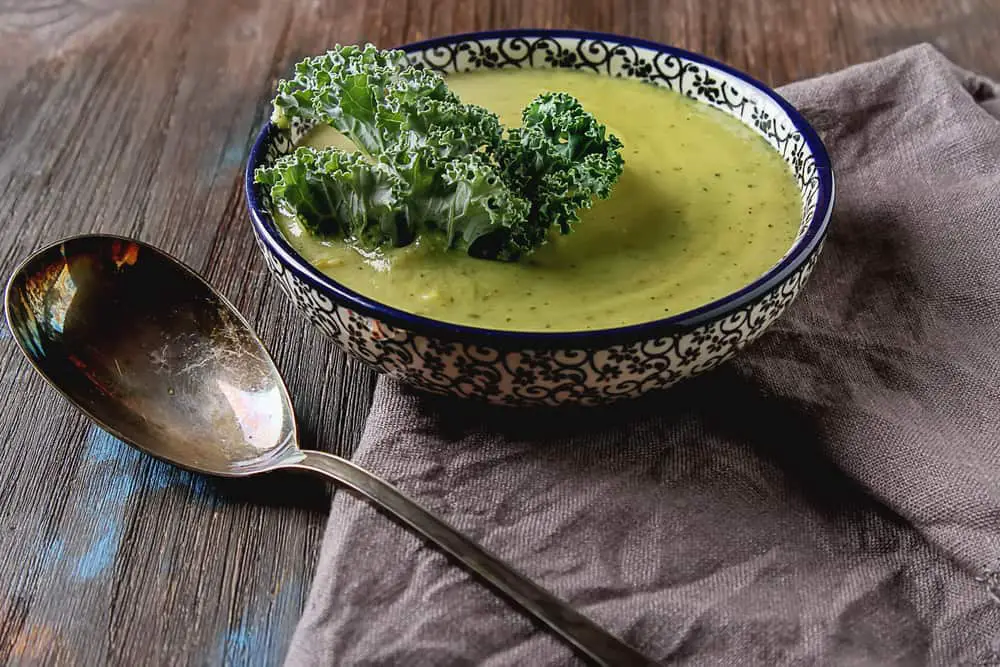Last Updated on 22nd April 2022 by
While grocery shopping, you see a nutrient-dense green cruciferous vegetable with a broadleaf called Kale and then buy some fresh ones. Now, you’re in your kitchen, but you’re uncertain how to cook it well in a soup.
Do you wonder how long it takes to cook Kale in soup? What should you do to prepare it and deal with the bitterness before cooking it in soup?
Preparing and cooking Kale in a soup can intimidate some, but it’s pretty straightforward if you know how to. Whenever I encounter a person saying something unpleasant about Kale, I would like to think that they just have not yet eaten a Kale dish cooked well.
Kale is an excellent source of vitamins A, K, B6, and C and calcium, potassium, copper, and manganese. Adding Kale to your diet is an excellent source of healthy nutrients that may help with blood pressure control, cancer prevention, digestive health improvement, and protection from type 2 diabetes.
But how long does it take to cook Kale in soup? Let’s find out!
What to do with Kale?
Kale was not a popular choice in the kitchen in America a long time ago. They used Kale primarily as a decorative foundation layer or topping piece in dishes prepared in buffets and restaurants.
However, more and more people have discovered the hidden wonders of this vegetable worthy of recognition. Since then, it has become a superfood and became the go-to food or spice for people who love to eat healthy food.
With its bitter aftertaste and the difficulty in cooking and eating kale, many people think kale is a challenging food to prepare. Truthfully, I do not think so!
Why? There’s a way to handle Kale to lessen its bitterness and texture once you cook it.
How to Prepare Kale for Soup
Cooking delicious soup with Kale does not need to be so complicated; just follow these easy steps. To make eating kale easier, cut off and discard the thick central rib of the leaf. This rib makes Kale bitter and makes it difficult to chew.
Most people include this rib part in their soup, so they eat a soup with a bitter aftertaste. If you want to cope with Kale’s bitterness, you need to know why it’s bitter.
Crushing the leaves releases some enzymes and kale compounds from their cell walls. Thus, organically speaking, it can also ward off hungry intruders when the barriers weaken and the two chemicals mix.
Now, back to the rib part. After discarding the thick central rib, with one hand, grasp the stem securely and carefully pull the leaf of the Kale off in one swift motion with the other.
Alternatively, you may use a sharp knife on each side of the rib to chop the leaf off for use. At the very least, it’s a great way to de-stress. Once you have finally de-stemmed your rib-free Kale, you may begin chopping.
How to Cook Kale for Soup
See? Preparing the Kale to cook for soup is not as complicated as most people think, right? Now that you have prepared your Kale well, it is time to cook them for soup.
You can choose how you want them to be cooked, either raw, boiled, or steamed.
Some research suggests that raw Kale is more beneficial for cancer prevention. In contrast, others show steaming Kale is better for you if you are cautious of your cholesterol levels since you won’t have to use too much oil and other seasonings.
The choice and preference are yours. Remember not to overcook it and don’t add too much liquid.
Alternatively, you may also try this method to cook Kale for your soup. You may cook it in a pan with a bit of oil. This method allows the vegetable to cook and be tender quickly with only a drizzle of olive oil and a few minced onions or garlic cloves.
You can also try braising kale. Like steaming, braising is also a healthy option since you won’t be using any oil. Slow-cooking the Kale reduces its bitterness, but it also helps soften the leaves to lessen the crunchy texture of the vegetable.
How Long to Cook Kale for Soup
How long does it exactly take to cook Kale for soup?
If you want to maintain the texture or the crispiness of the Kale itself and choose to simmer it with oil, remember to stir it periodically or around 4 to 5 minutes until the kale has wilted. The color of the Kale at this point should be around the brilliant green and still have a noticeable crunch.
If you choose to boil it, steam, or braise, I suggest putting it on a big pot that should be filled about three-quarter way with water and brought to a boil. This practice will also create some steam, so you may place the Kale in a steamer, colander, or sieve and heat it in a pot of water brought to a boil.
Once the water has been brought to a boil, simmer it down and cover for about an hour. Alternatively, you can also cover the saucepan and adjust the heat temperature down to low. Patience is the key here, so allow the soup to simmer for around 30 minutes before checking it.
After checking it, check if the texture of the Kale is to your liking through a fork. Don’t overcook the soup, and take it off the heat immediately if you want to preserve the crunch of the Kale. Remember that overcooking can affect its texture and taste and make your soup taste bitter.
With this article, you know how to prepare and cook kale to lessen the bitterness and how long it takes to cook them. You can start experimenting with kale and make fantastic recipes with the things and tips you have learned to fit your taste.
I'm Pauline, a mother of four grown children, my passion for cooking stemmed from the joy i get cooking for my family. I love to try new dishes, especially when dining out but creating and sharing my own recipes is my favourite thing to do!



bream
Friday 21st of February 2025
CtXMQ7ct1fz
salt
Friday 21st of February 2025
7La7YDuVzcW
Marcia C
Friday 16th of February 2024
Honestly, I just chopped up the Kale(minus the stems), and put it in my sausage potato soup towards the end and let it cook about 15 min. It was great, tender, and not bitter at all.
Robrites
Wednesday 7th of February 2024
This is a poorly written article designed to keep the reader on the page. Most of the information is incorrect or useless.